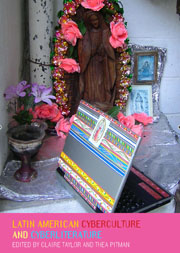Book contents
- Frontmatter
- Contents
- List of Illustrations
- Acknowledgements
- Foreword: Latin American Cyberliterature: From the Lettered City to the Creativity of its Citizens
- Notes on Contributors
- Introduction
- I Cyberculture and Cybercommunities
- 1 The New New Latin American Cinema: Cortometrajes on the Internet
- 2 Cyborgs, Cities, and Celluloid: Memory Machines in Two Latin American Cyborg Films
- 3 The Cyberart of Corpos Informáticos
- 4 Latin American Cyberprotest: Before and After the Zapatistas
- 5 Body, Nation, and Identity: Guillermo Gómez-Peña's Performances on the Web
- 6 Cyberspace Neighbourhood: The Virtual Construction of Capão Redondo
- 7 Literary E-magazines in Latin America: From Textual Criticism to Virtual Communities
- 8 Negotiating a (Border Literary) Community Online en la línea
- II Cyberliterature: Avatars and Aficionados
- A Cyberliterary Afterword: Of Blogs and Other Matters
- Conclusion: Latin American Identity and Cyberspace
- Suggested Further Reading
- Index
5 - Body, Nation, and Identity: Guillermo Gómez-Peña's Performances on the Web
from I - Cyberculture and Cybercommunities
- Frontmatter
- Contents
- List of Illustrations
- Acknowledgements
- Foreword: Latin American Cyberliterature: From the Lettered City to the Creativity of its Citizens
- Notes on Contributors
- Introduction
- I Cyberculture and Cybercommunities
- 1 The New New Latin American Cinema: Cortometrajes on the Internet
- 2 Cyborgs, Cities, and Celluloid: Memory Machines in Two Latin American Cyborg Films
- 3 The Cyberart of Corpos Informáticos
- 4 Latin American Cyberprotest: Before and After the Zapatistas
- 5 Body, Nation, and Identity: Guillermo Gómez-Peña's Performances on the Web
- 6 Cyberspace Neighbourhood: The Virtual Construction of Capão Redondo
- 7 Literary E-magazines in Latin America: From Textual Criticism to Virtual Communities
- 8 Negotiating a (Border Literary) Community Online en la línea
- II Cyberliterature: Avatars and Aficionados
- A Cyberliterary Afterword: Of Blogs and Other Matters
- Conclusion: Latin American Identity and Cyberspace
- Suggested Further Reading
- Index
Summary
The Internet is frequently heralded as a positive alternative space for the exploration of new identities, allowing the imaginative creation of a new self – or selves – that may or may not be carried through into everyday life (Laurel 2001: 110). The artist Guillermo Gómez-Peña invites Net-users to project themselves imaginatively onto others' lives, to explore alternative life narratives and purge their demons through his different projects. Through his work as a multimedia artist working both on- and off-line, he aims to make others aware of issues such as race, class, gender, and national allegiances, using multiple – often ludic – methods, in order to achieve radical social change. In this chapter, I shall examine some of the games, identities, and techniques used by Gómez-Peña as an online performer and consider his stated aims.
Techno-Razcuache Border Artist
Gómez-Peña was born in Mexico City and moved to the USA in 1978 where he works as a performance artist and writer. In terms of his artistic practice, he describes himself as a ‘migrant performance artist’ (Gómez-Peña 1994: 211) and ‘an interdisciplinary intellectual’ (Gómez-Peña 2005: xviii), and, with respect to his relationship to new technologies, as a ‘webback’ (Gómez-Peña 2005: viii), an unwilling ‘cyber-vato’ and an ‘information superhighway bandido’ (Gómez-Peña 2001: 281). In general terms, he tackles issues of the locatedness of cultures and the significance of borderlands, through an interrogation of the concept of a fixed nation space and an exploration of identity issues associated with such a conceptualisation of space.
- Type
- Chapter
- Information
- Latin American Cyberculture and Cyberliterature , pp. 111 - 122Publisher: Liverpool University PressPrint publication year: 2007



